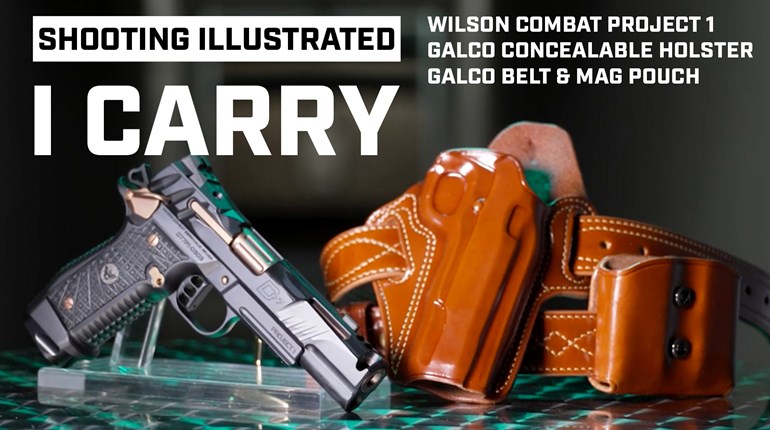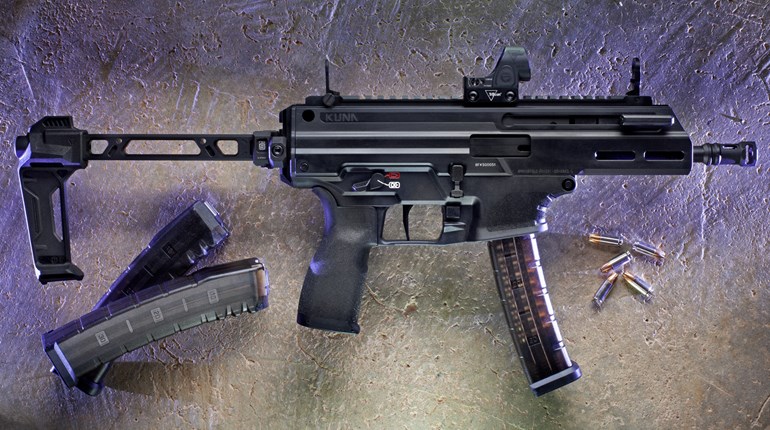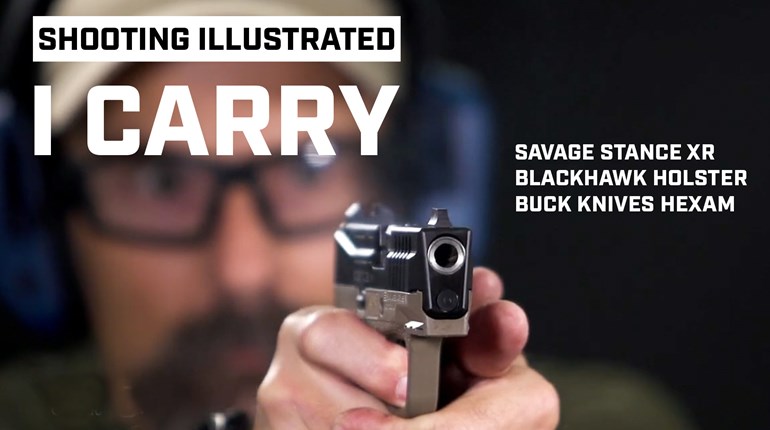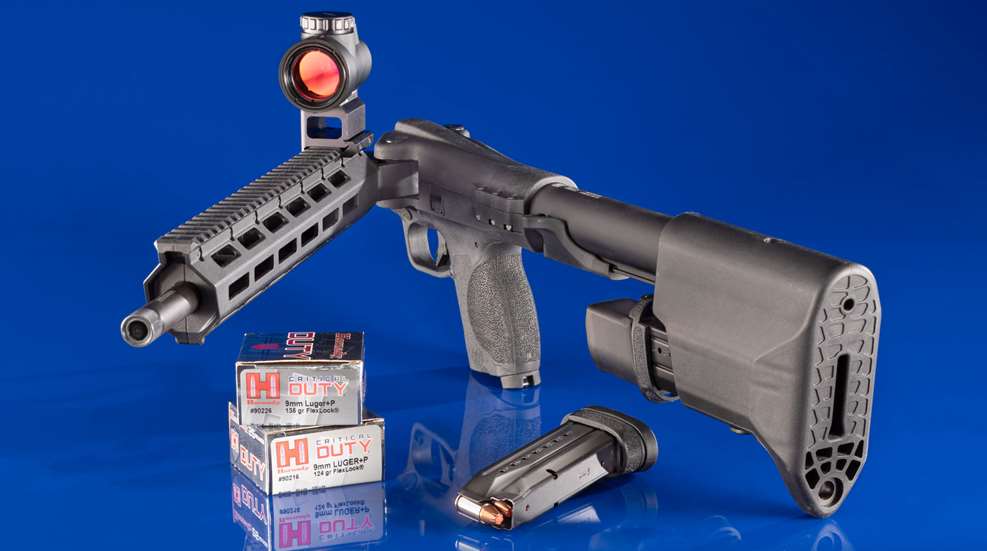
When I heard that Smith & Wesson was introducing a pistol-caliber carbine (PCC), I assumed it would be based on the company’s popular M&P15 line of AR-pattern carbines. That formula has worked for Colt for years, and more recently for Springfield Armory. Such an addition would build on the M&P15 series, adding a pistol-caliber to the standard rifle-caliber and rimfire offerings, and would give Smith & Wesson something for PCC fans and competitors. Boy, was I wrong about the FPC …
Instead, the company came out with a breech-folding carbine that takes compact M&P9 pistol magazines. It’s about as far from an AR-15-based PCC as one can get and still be a carbine. Magazines are inserted in the pistol grip, rather than forward of the trigger guard, so in that sense it’s similar to the Hi-Point 995 or the KelTec SUB2000.
I must admit, however, that I am smitten with the FPC. I’ve been a fan of M&P handguns since back in the ’aughts when they first hit the market. I went pretty much all-in, with full-size and compact 9 mm M&Ps and even a full-size .45 ACP. The M2.0 version of the M&P improved the trigger and added better grip texture, both of which are carried over on the FPC, as are the interchangeable backstraps. The feel of the FPC will be quite familiar to anyone who’s put any time behind the trigger of an M&P, which makes it an absolute natural as a home-defense carbine.

The folding nature of the FPC allows it to occupy a minimalist footprint, too. At a skosh more than 5 pounds empty and with a folded length of 16.4 inches, it fits in a wide variety of backpacks and even comes with its own nylon case for transport. This is handy, whether you’re headed to the range and wish to avoid the prying eyes of the neighborhood busybody, want something with a little more reach in your hiking backpack or are rounding out a bug-out bag with a potent carbine. It can be outfitted with a sound suppressor and still be shorter—when folded—than a standard, 16-inch-barrel AR-15 upper receiver with no muzzle device.
When it comes to home defense, the FPC has a lot going for it, too. If you’re familiar with the M&P handgun, the overall feel of the grip and trigger will be second nature. If you own an M&P9, the magazines are compatible. There are M-Lok slots on the handguard for the addition of a light, laser or grip; plentiful space on the Picatinny top rail for an optic, iron sights or both and there’s even a QD sling mount in the buttstock that can be combined with an M-Lok QD mount should you wish to add a sling. Also in the buttstock are two spaces specifically engineered to house two extra magazines securely, giving an on-board capacity in excess of 60 rounds.
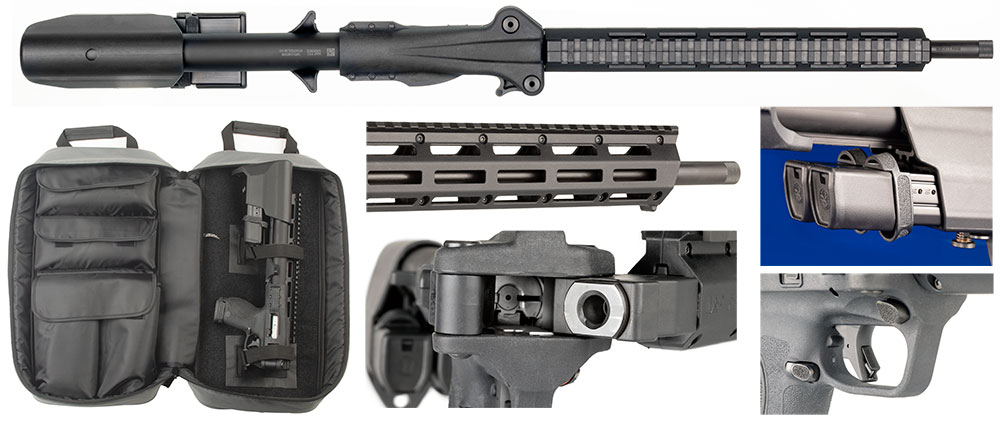
Owing to the carbine configuration, there are a couple notable departures from the standard M&P handgun. There’s a charging handle, of course—a rather odd-looking, ambidextrous paddle (lever?) on the underside of the stock tube. There’s a crossbolt safety rather than a thumb safety, as the traditional placement of the thumb safety could interfere with folding. Overall, though, there are more similarities than differences, as the FPC maintains many of the ergonomic features of the handgun line. Even the bolt-release lever is in (more or less) the same position as the slide release on the handgun, and it’s mirrored on both sides. That said, it is significantly easier to release the bolt by using the charging handle than by actuating the release lever. Overall, the FPC should be more familiar than not for M&P fans, a good thing.
Naturally, the folding nature of the FPC is one of the most interesting parts of this carbine. First off, there just aren’t that many breech-folding carbines out there; off the top of my head, there’s the KelTec SUB2000, the Magpul FDP (which, as of the writing of this article, is not actually available) and, well, I can’t find any others. Ruger’s PC Carbine has a takedown version that separates into two components, while other manufacturers have carbines with folding stocks, but there are precious few breech-folding variants. This new entry from Smith & Wesson folds to the side, which allows an optic to be placed on the Picatinny rail atop the polymer fore-end without impeding the folding mechanism. A lever on the right side of the FPC pushes forward to release the carbine for folding, which is accomplished with the bolt open or closed, with or without a magazine inserted. Always check the FPC is unloaded before folding.

Now, there’s that fore-end. I’m sure it’s polymer to save weight (and a few dollars, no doubt), though I’d feel better if it were aluminum and, well, not screwed together, but rather a solid piece. I did put 400 rounds through the FPC without disturbing the red-dot sight’s zero, so there’s no evidence of anything to worry about, but I would just like the part to which I attach an optic or sights to be some form of metal. To be fair, I’ve tested a few firearms where optics were mounted to polymer parts and had no problem, and in any case, this is a need the aftermarket can fill quickly. Companies like Midwest Industries have been quite responsive for niche items like handguards and optic mounts.
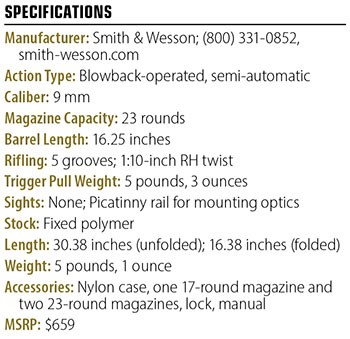 Operation of the FPC is simple: Unfold the carbine to start, then insert a magazine. Grasp the charging handle, pull rearward and release, and the FPC is ready. Simply disengage the safety and the gun is ready to go. To reverse the procedure, drop the magazine and run the charging handle a few times, then check the chamber. Twice. Push the lever to release the folding mechanism, and the charging handle itself acts as a latch to hold the two components together. At this point, it fits nicely in the included nylon carrying case, which contains numerous pockets for extra magazines, a cleaning kit and other essentials. It’s simple, efficient and intuitive. There’s a lot to like about that system.
Operation of the FPC is simple: Unfold the carbine to start, then insert a magazine. Grasp the charging handle, pull rearward and release, and the FPC is ready. Simply disengage the safety and the gun is ready to go. To reverse the procedure, drop the magazine and run the charging handle a few times, then check the chamber. Twice. Push the lever to release the folding mechanism, and the charging handle itself acts as a latch to hold the two components together. At this point, it fits nicely in the included nylon carrying case, which contains numerous pockets for extra magazines, a cleaning kit and other essentials. It’s simple, efficient and intuitive. There’s a lot to like about that system.
On the range, I started off by adding a red-dot sight. Since the FPC doesn’t come with any sights, you’ll need to attach an optic or add some form of irons. That’s a matter of personal preference; if the polymer construction of the rail has you concerned about mismatched surfaces, Magpul makes excellent polymer back-up sights. Once zeroed at 50 yards, I ran the FPC through our velocity- and accuracy-testing protocols, then set to work on some drills.
One drill I was curious about is the Rifle Mini-Navy Drill that was featured in our September 2023 “Skills Check” column by Jeff Gonzales. It’s a timed drill that tests your skill with a rifle at 5, 10 and 20 yards, and it fits well with what would be the most likely use of the FPC as a home-defense carbine. It made short work of the drills, even taking into account my (ahem) initial memory lapse on optic offset. The FPC did everything it was asked to do, with zero problems.
Two interesting things were discovered while testing the FPC. First, it was incredibly easy to shoot with one hand. Tuck the stock tight into the shoulder, and the light weight of the carbine—combined with a somewhat butt-heavy balance point—keeps the FPC on target easily, and making precise hits at 15 yards was easy with one hand only. Obviously, using both hands is preferable, but there’s no guarantee that will be possible in a dynamic incident. The second interesting thing was the magazine storage in the stock, specifically retrieving the magazines. It’s not difficult, by any stretch, but there’s a lever that pivots in the center: Press the right side and the left magazine is freed, and vice-versa. Don’t push the pivot point in the middle, as it won’t release anything that way.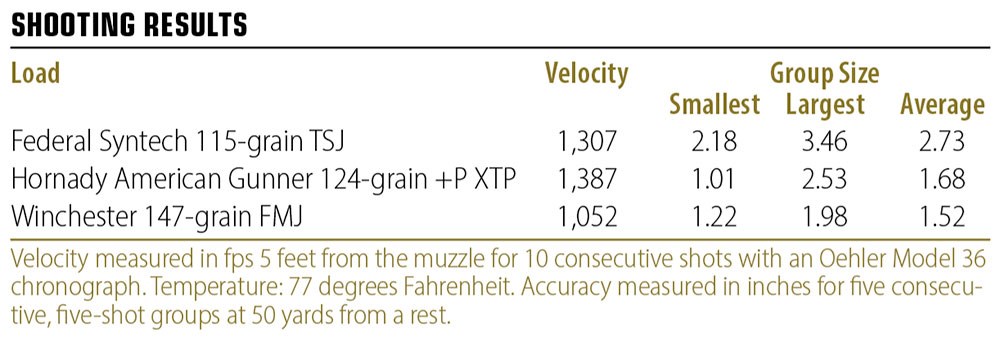
I fired 400 rounds of JHP and FMJ loads through the FPC without a single failure. Whether fired from a rest for accuracy testing or off the shoulder during a drill, whether it was fed bulk FMJ ammo or hollowpoints, everything worked. Loading magazines into the FPC, charging it, firing it, folding it and unfolding it resulted in no failures or difficulties of any kind. I even folded and unfolded the carbine about 40 or 50 times to see what effect it might have on the accuracy of the red-dot sight (none). Heck, even the thread-protector on the muzzle stayed in place throughout testing, requiring less than a quarter-turn to fully tighten at the very end. I bestow my highest compliment on Smith & Wesson’s FPC: It’s boring. It just plain works.













